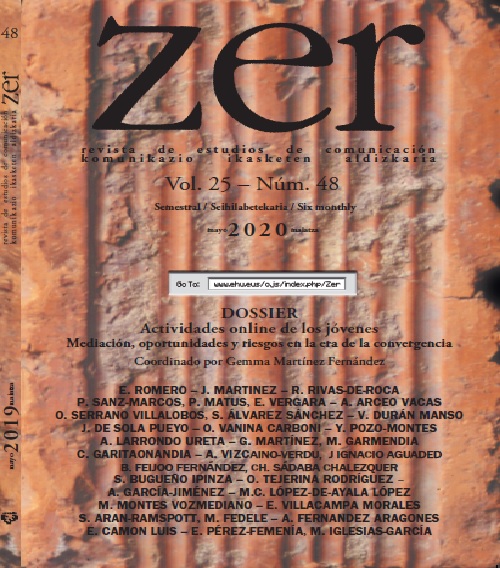Fugitives Characters in the Tennessee Williams Films: Sweet Bird of Youth (Richard Brooks, 1962) and the crisis of the Hays Code
##plugins.themes.bootstrap3.article.main##
##plugins.themes.bootstrap3.article.sidebar##
Abstract
The construction of the character is one of the main traits of one of the most adaptated writers of classic cinema, Tennessee Williams. Marked by the southern universe, his characters are grouped in ladies to the limit, tormented
young, dominant parents, integrated in life and fugitives, the most numerous. With the aim of treating its impact in a Hollywood determined by the Hays Code, the fugitives of the film Sweet Bird of Youth (Richard Brooks, 1962) are analyzed as a person and as a role. They also represented three topics condemned by the code that propitiated their crisis: drug addiction, prostitution and abortion.
How to Cite
##plugins.themes.bootstrap3.article.details##
character, history of cinema, Hollywood, censorship, melodrama.
BLACK, Gregory D. (1998). Hollywood censurado. Madrid: Cambridge University Press.
CASAS, Quim & IRIARTE, Ana Cristina (2009): Richard Brooks. San Sebastián-Madrid: Festival Internacional de cine de San Sebastián/ Filmoteca Española.
CASETTI, Franceso & DI CHIO, Federico (2007). Cómo analizar un film. Barcelona: Paidós.
CLUM, John M. (1997). "The sacrificial stud and the fugitive female in Suddenly, Last Summer, Orpheus Descending and Sweet Bird of Youth". In Roudané, Matthew C. (ed.), The Cambridge Companion to Tennessee Williams. Cambridge: Cambridge University Press, pp. 128-146.
DEVLIN, Albert J. y TISCHLER, Nancy M. (2004): The Selected Letters of Tennessee Williams. Volume II. 1945-1957. New York: New Directions.
DURÁN MANSO, Valeriano (2011). La complejidad psicológica de los personajes de Tennessee Williams. Frame, núm. 7, pp. 38-76. Recuperado de: http://fama2.us.es/fco/frame/frame7/estudios/1.3.pdf
DURÁN MANSO, Valeriano (2015): El dramatismo de los personajes de Tennessee Williams enel melodrama de Pedro Almodóvar: Tacones lejanos. En: Camarero, Enma y Marcos María (coords.) III Congreso Internacional Historia, Literatura y Arte en el Cine en español y portugués. Hibridaciones, transformaciones y nuevos espacios narrativos. Salamanca: Centro de Estudios Brasileños. Universidad de Salamanca. Tomo I, pp. 678-691.
FROME, Shelly (2001). The Actors Studio. A History. Jefferson: Mcfarland & Company.
GUARINOS, Virginia (2007). "Mujeres en proyección. La mujer en el cine. Teoría fílmica Feminista". En LOSCERTALES, Felicidad y NÚÑEZ, Trinidad (coords.) La mirada de las mujeres en la sociedad de la información. Madrid: Siranda, pp. 91-112.
HOLDITCH, Kenneth & Freeman Leavitt, Richard (2010). Tennessee Williams and the South. Jackson: University Press of Mississippi.
HOOPER, Michel S. D. (2014). "Pedro Almodovar's 'Homage' to Tennessee Williams". In Back, John S. (ed.) Tennessee Williams and Europe. Interculrural Encounters, Transatlantic Exanges. Amsterdam: Rodopi, pp. 347-367.
PALLER, Michael (2014). "Their Date with Each Other from the Beginning: Tennessee Williams and Harold Pinter". In Back, John S. (ed.), Tennessee Williams and Europe. Interculrural Encounters, Transatlantic Exanges. Amsterdam: Rodopi, pp. 281-297.
PALMER, R. Barton (1997). "Hollywood in crisis: Tennessee Williams and the evolution of the adult film". In Roudané, Matthew C. (ed.), The Cambridge Companion to Tennessee Williams. Cambridge: Cambridge University Press, pp. 204-231.
PALMER, R. Barton & BRAY, Robert (2009). Hollywood's Tennessee. The Williams Films and Postwar America. Austin: University of Texas Press.
PALMER, R. Barton (2014). "The View from Here and Abroad: Tennessee Williams and 1950s Hollywood Cinema". In Back, John S. (ed.) Tennessee Williams and Europe. Interculrural Encounters, Transatlantic Exanges. Amsterdam: Rodopi, pp. 111-130.
PHILLIPS, G. D. (1980). The Films of Tennessee Williams. Philadelphia: Art Alliance.
RODRÍGUEZ DE AUSTRIA GIMÉNEZ DE ARAGÓN, Alfonso. (2015). "El código de producción de Hollywood (1930-1966): censura, marcos (frames) y hegemonía". ZER. Revista de Estudios en Comunicación, Vol. 20, núm. 39, pp. 177-193. Recuperado de: https://www.ehu.eus/ojs/index.php/Zer/article/view/15533
SMITH-HOWARD, A & HEINTZELMAN, G. (2005). Critical Companion to Tennessee Williams. A literary Reference to His Life and Work. New York: Checkmark.
SPOTO, Donald (1985): The Kindness of Strangers. The Life of Tennessee Williams. Boston: Da Capo Press.
STEEN, Mike (1969). A Look at Tennessee Williams. New York: Hawthorn.
WILLIAMS, Tennessee (2009): Sweet Bird of Youth and Other Plays.
Period of Adjustment and The Night of the Iguana. London: Penguin.
WILLIAMS, Tennessee (2008). Memorias. Barcelona: Ediciones B.
YACOWAR, Maurice (1977): Tennessee Williams & Film. New York: Frederick Ungar.

This work is licensed under a Creative Commons Attribution-NonCommercial-NoDerivatives 4.0 International License.
(c) UPV/EHU Press

